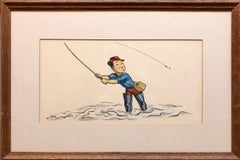Louise Bourgeois Art
Louise Joséphine Bourgeois was a French-American artist. Although she is best known for her large-scale sculpture and installation art, Bourgeois was also a prolific painter and printmaker. She explored a variety of themes throughout her long career, including domesticity and the family, sexuality and the body, as well as death and the unconscious. These themes connect to events from her childhood, which she considered to be a therapeutic process. Although Bourgeois exhibited with the Abstract Expressionists and her work has much in common with Surrealism and Feminist art, she was not formally affiliated with a particular artistic movement.
Late 20th Century Louise Bourgeois Art
Ink, Illustration Board
1950s Realist Louise Bourgeois Art
Gouache, Illustration Board, Ink
1930s American Modern Louise Bourgeois Art
India Ink, Watercolor, Illustration Board
1930s Naturalistic Louise Bourgeois Art
Archival Ink, Watercolor, Illustration Board
1890s American Impressionist Louise Bourgeois Art
India Ink, Illustration Board
1930s American Modern Louise Bourgeois Art
India Ink, Watercolor, Illustration Board
1960s Modern Louise Bourgeois Art
Ink, Illustration Board
1930s Naturalistic Louise Bourgeois Art
Archival Ink, Watercolor, Illustration Board
1950s Louise Bourgeois Art
Ink, Illustration Board, Pen
1950s Louise Bourgeois Art
Ink, Illustration Board, Pen
1960s Louise Bourgeois Art
Ink, Illustration Board, Pen
1960s Louise Bourgeois Art
Ink, Illustration Board, Pen
Early 2000s Suprematist Louise Bourgeois Art
Ink, Illustration Board
Louise Bourgeois art for sale on 1stDibs.
Artists Similar to Louise Bourgeois
- 1stDibs ExpertOctober 7, 2024The difference between drypoint and engraving is that these two types of prints involve different techniques. An engraving is a print made by incising lines into a metal plate with a sharp tool called a burin. After the image is drawn, the plate is inked, wiped clean, and then firmly pressed to paper so the ink remaining in the incised grooves is transferred. Considerable force is required to mark the metal, so the lines made by engraving tend to be stronger than those made through etching and characterized by gentle tapering. Light and shade have to be created through cross-hatching since the technique is line-based. Drypoint is similar to engraving in that an artist incises a metal plate with a sharp tool. As the metal is carved, metal shavings, also called the burr, build up in the grooves. But unlike with engraving, the burr is not cleaned away with drypoint, resulting in very soft, velvety lines. Since the burr slowly wears away with each printing, fewer impressions can be made, and the first impression tends to be stronger than the last, a characteristic that sets the technique apart from many other printing methods. Explore a selection of engravings and drypoint prints on 1stDibs.
- 1stDibs ExpertAugust 26, 2024No, Louise Bourgeois was not a Surrealist artist. Although her work has much in common with Surrealist and Feminist art, she was not formally affiliated with a particular artistic movement. She explored a variety of themes throughout her career, including domesticity, the family, sexuality, the body, death and the unconscious. On 1stDibs, find a selection of Louise Bourgeois art.

